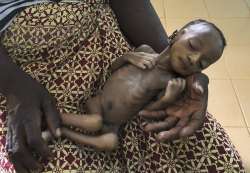10,000 child die due to coronavirus-linked hunger every month in West Africa
All around the world, the coronavirus and its restrictions are pushing already hungry communities over the edge, cutting off meager farms from markets and isolating villages from food and medical aid.

The lean season is coming for Burkina Faso’s children. And this time, the long wait for the harvest is bringing a hunger more ferocious than most have ever known. That hunger is already stalking Haboue Solange Boue, an infant who has lost half her former body weight of 5.5 pounds (2.5 kilograms) in the last month. With the markets closed because of coronavirus restrictions, her family sold fewer vegetables. Her mother is too malnourished to nurse her.
“My child,” Danssanin Lanizou whispers, choking back tears as she unwraps a blanket to reveal her baby’s protruding ribs. The infant whimpers soundlessly.
All around the world, the coronavirus and its restrictions are pushing already hungry communities over the edge, cutting off meager farms from markets and isolating villages from food and medical aid. Virus-linked hunger is leading to the deaths of 10,000 more children a month over the first year of the pandemic, according to an urgent call to action from the United Nations shared with The Associated Press ahead of its publication in the Lancet medical journal.
Quick Recap Coronavirus and its restrictions are pushing already hungry communities over the edge According to UN, more than 550,000 children are stuck by wastingFurther, more than 550,000 additional children each month are being struck by what is called wasting, according to the U.N. — malnutrition that manifests in spindly limbs and distended bellies. Over a year, that’s up 6.7 million from last year’s total of 47 million. Wasting and stunting can permanently damage children physically and mentally, transforming individual tragedies into a generational catastrophe.
“The food security effects of the COVID crisis are going to reflect many years from now,” said Dr. Francesco Branca, the World Health Organization head of nutrition. “There is going to be a societal effect.”
In Burkina Faso, for example, one in five young children is chronically malnourished. Food prices have spiked, and 12 million of the country’s 20 million residents don’t get enough to eat.
Lanizou’s husband, Yakouaran Boue, used to sell onions to buy seeds and fertilizer, but then the markets closed. Even now, a 50-kilogram bag of onions sells for a dollar less, which means less seed to plant for next year.
“I’m worried that this year we won’t have enough food to feed her,” he said, staring down at his daughter over his wife’s shoulder. “I’m afraid she’s going to die.”
From Latin America to South Asia to sub-Saharan Africa, more families than ever are staring down a future without enough food. The analysis published Monday found about 128,000 more young children will die over the first 12 months of the virus.
In April, World Food Program head David Beasley warned that the coronavirus economy would cause global famines “of biblical proportions” this year. There are different stages of what is known as food insecurity; famine is officially declared when, along with other measures, 30% of the population suffers from wasting.
The agency estimated in February that one in every three people in Venezuela was already going hungry, as inflation rendered many salaries nearly worthless and forced millions to flee abroad. Then the virus arrived.
“The parents of the children are without work,” said Annelise Mirabal, who works with a foundation that helps malnourished children in Maracaibo, the city in Venezuela thus far hardest hit by the pandemic. “How are they going to feed their kids?”
Girls push children in a cart near the market in the town of Hounde, Tuy Province, in southwestern Burkina Faso on Thursday, June 11, 2020. (AP Photo/Sam Mednick)
These days, many new patients are the children of migrants who are making long journeys back to Venezuela from Peru, Ecuador or Colombia, where their families became jobless and unable to buy food during the pandemic. Others are the children of migrants who are still abroad and have not been able to send back money for more food.
“Every day we receive a malnourished child,” said Dr. Francisco Nieto, who works in a hospital in the border state of Tachira. He added that they look “like children we haven’t seen in a long time in Venezuela,” alluding to those in famines in parts of Africa.
In May, Nieto recalled, after two months of quarantine in Venezuela, 18-month-old twins arrived at his hospital with bodies bloated from malnutrition. The children’s mother was jobless and living with her own mother. She told the doctor she had only been able to feed them a simple drink made with boiled bananas.
“Not even a cracker? Some chicken?” he asked. “Nothing,” the children’s grandmother responded.
When doctors tried to treat them, one of the boys developed “refeeding syndrome,” where food can result in metabolic abnormalities. Eight days later, he died.
Nieto said aid groups have provided some relief, but their work has been limited by COVID-19 quarantines. A home set up in Tachira to receive malnourished children after they are released from the hospital is no longer in operation. So now children are sent directly back to their families, many of whom are still unable to feed them properly.
“It’s very frustrating,” Nieto said. “The children get lost.”
